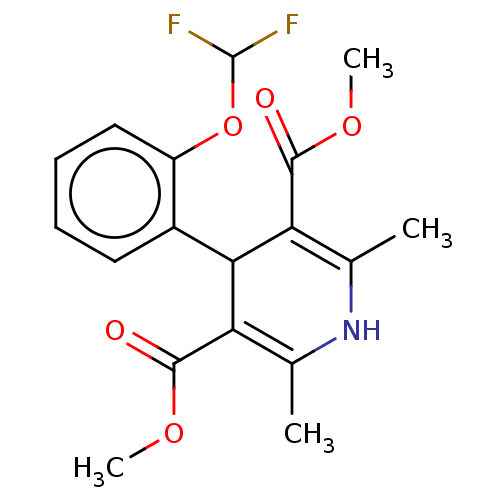BDBM50103630 Riodipine
SMILES COC(=O)C1=C(C)NC(C)=C(C1c1ccccc1OC(F)F)C(=O)OC
InChI Key InChIKey=AZVFIZVKGSPGPK-UHFFFAOYSA-N
Data 4 EC50
Activity Spreadsheet -- Enzyme Inhibition Constant Data from BindingDB
 Found 4 hits for monomerid = 50103630
Found 4 hits for monomerid = 50103630
TargetNuclear receptor subfamily 1 group I member 2(Homo sapiens (Human))
National Institutes Of Health Chemical Genomics Center
Curated by ChEMBL
National Institutes Of Health Chemical Genomics Center
Curated by ChEMBL
Affinity DataEC50: 4.00E+3nMAssay Description:Activation of human PXR expressed in human HepG2 (DPX-2) cells after 24 hrs by luciferase reporter gene based luminescent analysisMore data for this Ligand-Target Pair
TargetNuclear receptor subfamily 1 group I member 2(Homo sapiens (Human))
National Institutes Of Health Chemical Genomics Center
Curated by ChEMBL
National Institutes Of Health Chemical Genomics Center
Curated by ChEMBL
Affinity DataEC50: 1.41E+4nMAssay Description:Competitive binding affinity to human PXR LBD (111 to 434) by TR-FRET assayMore data for this Ligand-Target Pair
TargetNuclear receptor subfamily 1 group I member 2(Homo sapiens (Human))
National Institutes Of Health Chemical Genomics Center
Curated by ChEMBL
National Institutes Of Health Chemical Genomics Center
Curated by ChEMBL
Affinity DataEC50: 1.60E+3nMAssay Description:Activation of human PXR expressed in human HepG2 (DPX-2) cells assessed as induction of CYP3A4 after 24 hrs by luminescent analysisMore data for this Ligand-Target Pair
TargetNuclear receptor subfamily 1 group I member 2(Rattus norvegicus)
National Institutes Of Health Chemical Genomics Center
Curated by ChEMBL
National Institutes Of Health Chemical Genomics Center
Curated by ChEMBL
Affinity DataEC50: 1.80E+3nMAssay Description:Activation of rat PXR expressed in human HepG2 cells after 24 hrs by luciferase reporter gene based luminescent analysisMore data for this Ligand-Target Pair
